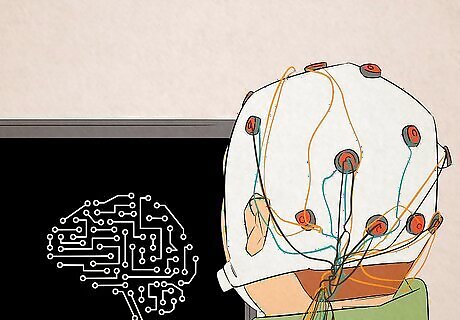
views
- Build and use a Faraday cage made of wire mesh or aluminum to block potentially mind-reading electromagnetic fields (EMFs).
- Wear infrared-reflective glasses to keep face-scanning cameras and face readers from viewing you. The infrared on the glasses will block digital surveillance.
- There’s a lot of research and emerging tech dealing with mind-reading, but there are no mind-reading waves or hidden projects infiltrating the public to worry about.
Blocking Mind Reading Tech

Faraday cage A Faraday cage is a protective container designed to block electromagnetic radiation and break up rogue radio waves. Make a Faraday cage by wrapping a room (or a container for electronics) in wire mesh and aluminum foil and you’ll be protected. This should block any theoretical mind-reading waves or energies. Any conductive material works. You can make a Faraday cage out of aluminum, steel, or even a metal trash can. It really is that easy. People use Faraday cages all the time in places like hospitals, airports, and courts where you need to protect special sensors or computers from interference.

Infrared-reflecting glasses Put on a pair of these glasses to block surveillance cameras or facial analysis devices. The infrared reflection will light up on cameras like it’s the Fourth of July to make your head look like a glowing orb, rending the cameras useless. This is a good alternative to walking around with your entire face covered, which is illegal in some cases. The most popular manufacturers of these glasses are Reflectacles and Sunphey Optical.

Copper bracelets Copper can, in theory, interfere with electromagnetic field (EMF) waves and break them up. If you believe that mind-reading technology may use electromagnetic fields, simply put on a copper bracelet to protect yourself. There are a lot of copper products that claim to help relieve pain or arthritis, but there’s no scientific evidence it provides any benefit.

Tin foil hat There’s some truth in the aluminum foil hat meme. Aluminum can block electric waves and radiation, which is why it’s a popular option for Faraday cages. If you’re worried about something reading your thoughts, make an aluminum foil hat and put it on. While “brain-reading” wave tech doesn't really exist, tin foil hats are an easy and cheap way to block them in theory.

Electronics avoidance You never really know when a phone or microphone is recording unless you control it yourself. And then you have to consider the fact that there are cameras everywhere these days, so you can never know who is watching. Just avoid electronics in general and you’ll minimize the odds you’re exposed to any invasive technology. This isn’t to say you should be scared to hang out in an arcade, use your phone, or visit an area with a lot of tech. There is no hidden mind-reading tech that exists that you should be that diligent about avoiding.

Alternative or encrypted forms of communication Avoid talking over the phone and communicate in person whenever possible. If you do talk in person, cover your mouth to avoid lip-reading devices or use Pig Latin. When it comes to digital communication, use a VPN to disguise your IP address and encrypt the files on your computer to keep people from hacking in.

Protesting and political advocacy Mind-reading technology is still being developed, and we’re barely on the edge of discovering a tenth of what’s possible. But what can keep that technology from running amok as it is developed? Your advocacy. Make your voice heard and advocate for privacy rights by contacting your local representatives and organizing in your community to make sure people are aware of the risks of mind-reading tech.
What kind of mind-reading tech exists?

Real mind-reading tech requires heavy machines and headgear. To be totally clear, there is no mind-reading tech floating around in the public right now. Scientists do have the ability to interpret certain kinds of thoughts, but this would require you to get a medical procedure, be hooked up for an EEG, or get an fMRI. These heavy machines measure the tiny electrical signals from your brain cells that can be interpreted by scientists or medical professionals, but they do not "read" your thoughts outright. There are brain decoders that people who can’t speak use to communicate (Stephen Hawking famously used one). You’d know if you were hooked up to one, though. There are a lot of fun projects going on right now surrounding ChatGPT, AI, and thought interpretation, but all of that is just barely being explored right now.

Some believe that data collection counts as a kind of mind reading. You know when you go online to search for new jeans and then the next day you see all kinds of advertisements for clothes? Nobody is reading your mind—they’re just taking your behavior and using it to predict what you want. Social media is notorious for this. They track what you click on or spend your time looking at and use this to make assumptions about what you want to see online. It’s easy to mistake this kind of thing as mind-reading tech, but nobody is actually going into your brain or anything like that. It’s just companies trying to sell you things based on your online behavior. Unfortunately, there isn’t much you can do about this outside of using a VPN and avoiding social media altogether.




















Comments
0 comment